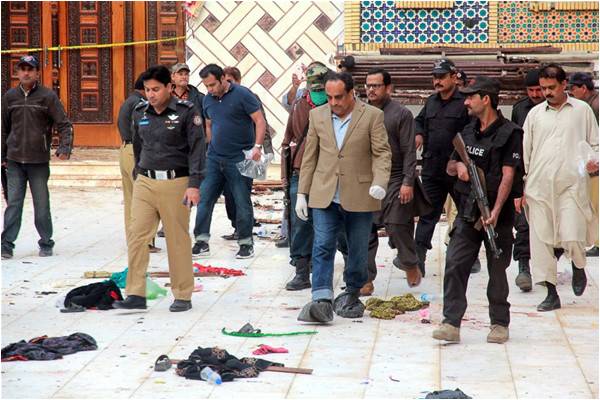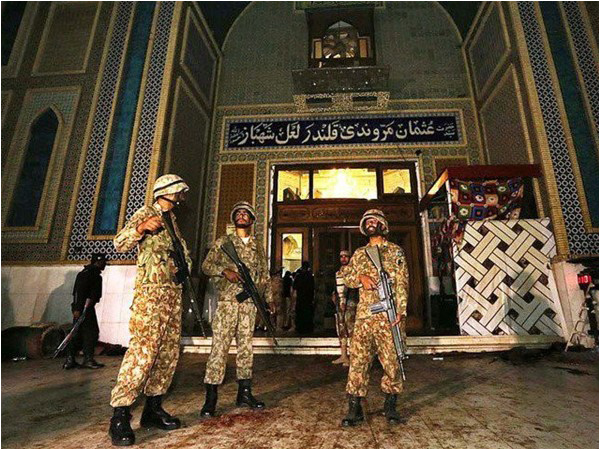
The militant Islamic State group may have claimed responsibility for the suicide bombing at the shrine of Lal Shahbaz Qalandar in Sehwan, but senior law-enforcement officials and security analysts believe that local militant groups operating in the northern parts of Sindh for several years are behind it.
On the evening of Feb 16, a suicide bomber blew himself up at the shrine that is located in district Jamshoro. He killed at least 90 people and left hundreds more injured. The bombing was seen by many as a continuation of a series of terrorist attacks which took place across Pakistan in the week, leaving 112 dead. But law-enforcement agencies in Sindh have been linking it to local militant groups, which they say were behind similar attacks in recent years in the province’s rural areas, especially its northern districts of Jacobabad and Shikarpur.
In October 2015, a suicide bomber targeted a Muharram procession in Lashari Mohallah neighbourhood of Jacobabad, killing at least 26 mourners, including children, and injuring many others. A similar attack on an imambargah in Shikarpur in January 2015 also killed over 57 people.
Connecting the string of subversive attacks in rural parts of Sindh, the provincial police chief, AD Khawaja, said that Hafeez Brohi’s group could be involved. This assessment is backed by Omar Shahid Hamid, an SSP with the Counter-Terrorism Department (Intelligence). According to him, the law-enforcement agencies have been vigorously looking for Brohi and his accomplices, and so far, have arrested some of his facilitators from Dadu and Jamshoro. “Because of his history and connections with militant outfits, we are confident that Hafeez Brohi’s group is behind the shrine attack,” said Hamid, who visited the northern districts after the attack. “His group was mainly active in northern parts of Sindh. But the recent attack in Sehwan shows that the group is now making inroads in central parts of the province.”

Hafeez Brohi, 35, is a resident of Shikarpur’s Abdul Khaliq Pandrani village. In its seventh Red Book, the Sindh police affiliated him with several proscribed outfits, including Lashkar-e-Jhangvi’s Asif Chotu faction, the Tehreek-e-Taliban Pakistan and the Jaish-e-Muhammad. Hamid said that Brohi went to Afghanistan in 2007-08 and started his subversive activities in 2010 by attacking a Sufi spiritual leader. One of his brothers was killed in a suicide attack in Afghanistan.
Police officials and security analysts believe that militant groups operating on the border of Balochistan and south Punjab have recently made nexuses with outfits in Sindh. Sindh Police’s CTD officers said that the groups, including the TTP and the LeJ, had found sanctuaries in Wadh of Khuzdar in Balochistan, where Shafiq Mengal and Amanullah Zehri, local militants, have been aiding them.
“From there, they [militants] have been planning attacks in Karachi and the rest of the province,” said Hamid. After the ongoing crackdown against militant groups started in Karachi, FATA and other parts of the country, many of their militants have been shuttling between the bordering districts of Balochistan and Sindh, such as Qambar Shahdadkot, Shikarpur and Jacobabad, the region that is ideal for the militant groups strategically, according to the CTD officials.
In September 2016, Brohi also sent two suicide bombers to attack Eid-ul-Adha prayers in Shikarpur. One blew himself up but another, who was identified as Usman, failed to detonate his vest and was arrested. During interrogations, Usman said that both of them had stayed at Wadh for a day before coming to Shikarpur for the attack. A few months ago, the CTD has written letters urging the federal, Sindh and Balochistan governments to undertake a massive crackdown against new sanctuaries in Khuzdar.
Also, proscribed jihadi groups headquartered in south Punjab have been also active in northern Sindh. A report of the United States Institute for Peace, a Washington-DC based think tank, released in 2015, said that proscribed sectarian militant groups and the TTP are consolidating their presence in Sindh’s northern areas.“Ensuing stability in Sindh is key to tackling the security situation in Karachi and in preventing the spread into the province of violent extremist and sectarian groups based in southern Punjab,” the report said.
Analysts, who monitor the province’s security issues, believe that northern parts of Sindh have been witnessing a rise in militant attacks for the past few years. “Tough Sindh is famous for its religious pluralism and progressive politics and is called the land of the Sufis, but the plague of extremism in the past few years has quietly been engulfing the province’s northern parts,” said Sohail Sangi, a political analyst. He said that the ruling Pakistan People’s Party’s bad governance and the lack of an alternative political force, has given space to madrassas to mushroom and has led to fierce tribal clashes which are key factors behind the strengthening of extremist forces in the region.
“In recent years, religious groups replaced the Left and nationalist parties, establishing a chain of madrassas at all entry and exit points of all districts, where, because there are no proper schools and teachers, they offer free education and food to the poor,” Sangi said.
The writer works for The News International in Karachi @zalmayzia
On the evening of Feb 16, a suicide bomber blew himself up at the shrine that is located in district Jamshoro. He killed at least 90 people and left hundreds more injured. The bombing was seen by many as a continuation of a series of terrorist attacks which took place across Pakistan in the week, leaving 112 dead. But law-enforcement agencies in Sindh have been linking it to local militant groups, which they say were behind similar attacks in recent years in the province’s rural areas, especially its northern districts of Jacobabad and Shikarpur.
After the ongoing crackdown against militant groups started in Karachi, FATA and other parts of the country, many of their militants have been shuttling between the bordering districts of Balochistan and Sindh, such as Qambar Shahdadkot, Shikarpur and Jacobabad
In October 2015, a suicide bomber targeted a Muharram procession in Lashari Mohallah neighbourhood of Jacobabad, killing at least 26 mourners, including children, and injuring many others. A similar attack on an imambargah in Shikarpur in January 2015 also killed over 57 people.
Connecting the string of subversive attacks in rural parts of Sindh, the provincial police chief, AD Khawaja, said that Hafeez Brohi’s group could be involved. This assessment is backed by Omar Shahid Hamid, an SSP with the Counter-Terrorism Department (Intelligence). According to him, the law-enforcement agencies have been vigorously looking for Brohi and his accomplices, and so far, have arrested some of his facilitators from Dadu and Jamshoro. “Because of his history and connections with militant outfits, we are confident that Hafeez Brohi’s group is behind the shrine attack,” said Hamid, who visited the northern districts after the attack. “His group was mainly active in northern parts of Sindh. But the recent attack in Sehwan shows that the group is now making inroads in central parts of the province.”

Hafeez Brohi, 35, is a resident of Shikarpur’s Abdul Khaliq Pandrani village. In its seventh Red Book, the Sindh police affiliated him with several proscribed outfits, including Lashkar-e-Jhangvi’s Asif Chotu faction, the Tehreek-e-Taliban Pakistan and the Jaish-e-Muhammad. Hamid said that Brohi went to Afghanistan in 2007-08 and started his subversive activities in 2010 by attacking a Sufi spiritual leader. One of his brothers was killed in a suicide attack in Afghanistan.
Police officials and security analysts believe that militant groups operating on the border of Balochistan and south Punjab have recently made nexuses with outfits in Sindh. Sindh Police’s CTD officers said that the groups, including the TTP and the LeJ, had found sanctuaries in Wadh of Khuzdar in Balochistan, where Shafiq Mengal and Amanullah Zehri, local militants, have been aiding them.
“From there, they [militants] have been planning attacks in Karachi and the rest of the province,” said Hamid. After the ongoing crackdown against militant groups started in Karachi, FATA and other parts of the country, many of their militants have been shuttling between the bordering districts of Balochistan and Sindh, such as Qambar Shahdadkot, Shikarpur and Jacobabad, the region that is ideal for the militant groups strategically, according to the CTD officials.
In September 2016, Brohi also sent two suicide bombers to attack Eid-ul-Adha prayers in Shikarpur. One blew himself up but another, who was identified as Usman, failed to detonate his vest and was arrested. During interrogations, Usman said that both of them had stayed at Wadh for a day before coming to Shikarpur for the attack. A few months ago, the CTD has written letters urging the federal, Sindh and Balochistan governments to undertake a massive crackdown against new sanctuaries in Khuzdar.
Also, proscribed jihadi groups headquartered in south Punjab have been also active in northern Sindh. A report of the United States Institute for Peace, a Washington-DC based think tank, released in 2015, said that proscribed sectarian militant groups and the TTP are consolidating their presence in Sindh’s northern areas.“Ensuing stability in Sindh is key to tackling the security situation in Karachi and in preventing the spread into the province of violent extremist and sectarian groups based in southern Punjab,” the report said.
Analysts, who monitor the province’s security issues, believe that northern parts of Sindh have been witnessing a rise in militant attacks for the past few years. “Tough Sindh is famous for its religious pluralism and progressive politics and is called the land of the Sufis, but the plague of extremism in the past few years has quietly been engulfing the province’s northern parts,” said Sohail Sangi, a political analyst. He said that the ruling Pakistan People’s Party’s bad governance and the lack of an alternative political force, has given space to madrassas to mushroom and has led to fierce tribal clashes which are key factors behind the strengthening of extremist forces in the region.
“In recent years, religious groups replaced the Left and nationalist parties, establishing a chain of madrassas at all entry and exit points of all districts, where, because there are no proper schools and teachers, they offer free education and food to the poor,” Sangi said.
The writer works for The News International in Karachi @zalmayzia

